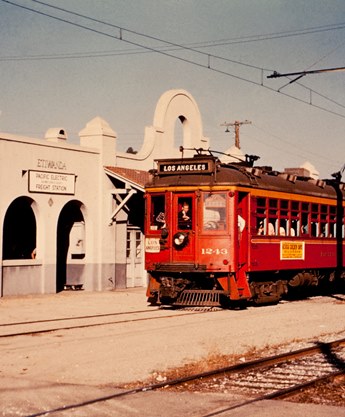The former Etiwanda Pacific Electric Depot is badly in need of repair, and the city is looking for an outside party to help with its restoration. What the building will be transformed into has yet to be determined.
Rancho Cucamonga is trying to bring back a piece of its distant past.
The city wants to restore the former Etiwanda Pacific Electric Depot, a 104-year-old structure at 7089 Etiwanda Ave. that was once a stop on the Pacific Electric Red Car line that traveled to and from downtown Los Angeles, among other locations.
Built in 1914, the depot was one of the first concrete tilt-up buildings constructed in Southern California. In 2011 the building was placed on the National Register of Historic Places and the California Register of Historical Resources.
It was designed by Irving Gill, a well-known Southern California architect at the time whose designs were known for their simplicity and for being easy to maintain.
Besides being the local stop on the Red Car line, the depot was used by Inland citrus growers to transport their fruit.
By the early 1960s the depot shut down, the growing popularity of automobiles and freeways having caused many of the Pacific Red Line route to be eliminated. The building has been vacant since the mid-2000s.
City officials haven’t determined what they want the building to become, although office, retail or a combination of the two is a possibility, said Lori Sassoon, deputy city manager.
“It’s worn down, and it will take lot of work to get it back,” Sassoon said. “But it’s an important part of Rancho Cucamonga’s history, and the city has a great opportunity. The challenge is to come up with something that will make the property economically viable.”
Whatever it decides to do, the city doesn’t plan on doing it by itself. It has put out a request for a “qualified entity” that it can partner with and restore the building, which covers approximately 3,200 square feet.
Whoever the city selects will rehabilitate the building and then be responsible for maintaining it and overseeing its day-to-day operations, according to the guidelines established in a city staff report.
The city – which bought the property about 10 years ago from the San Bernardino Associated Governments, now called the San Bernardino County Transportation Authority – will offer the second party a “long-term” lease.
In exchange for that, the partner will pay for the former depot’s restoration, the cost of which is not specified in the report. Rancho Cucamonga does have approximately $150,000 in community development block grant funds from the U.S. Department of Housing and Urban Development that it plans to use to help replace doors and windows at the former depot.
Also, by entering into a long-term lease with the city, the partner could be eligible for federal historic preservation tax incentives that could cover up to 20 percent of the restoration cost, assuming the project is eligible.
First phase of the project, planned for this fall, will be grading the parking area north of the depot and building an asphalt parking lot there. Utilities would be installed underground and extended from there to the east side of the depot.
The second phase, scheduled for next summer, will include more improvements to the building, which is boarded up and surrounded by a chainlink fence topped with barbed wire. Overhead utilities along Etiwanda Avenue will be buried, utility poles will be removed and a street light on top of a concrete pole will be constructed.
If more environmental studies are needed, those timelines could be extended by six to nine months, according to the staff report.
In the early 2000’s, the former Pacific Electric right-of-way was transformed into the Pacific Electric Trail, a 21-mile pathway for joggers, bikers and other commuters that runs from Rialto on the east to Claremont on the west.
The Pacific Electric Trail has been popular practically since the day it opened, and whatever the city decides to do with the property it should tie into that, said Vicki Jones, president of the non-profit Friends of the Pacific Electric Trail.
“It’s a beautiful, historic building and it needs to be preserved,” Jones said. “The city should do whatever it can to save. It’s one of the few buildings of its kind left in California.”
In its day, the Red Car line was invaluable to the Inland region. It started in San Bernardino and went to Pasadena, Los Angeles, Santa Monica and Long Beach.
“Everywhere except San Diego,” said Jones, whose organization is one of several community groups that have undertaken interim projects, including roof repairs and lead abatement, meant to preserve the depot.
Putting retail at the former depot is a risky proposition, Jones believes.
“We think it should be a community gathering place, maybe with a snack bar, where people can park their bikes and hang out,” Jones said. “ But it’s in a residential area and near an elementary school. We would rather see something else there besides retail.”
 IE Business Daily Business news for the Inland Empire.
IE Business Daily Business news for the Inland Empire.


